David Berkow1*
1Department of Optometry, Berkow Optometrists, Israel
*Corresponding Author: David Berkow, Department of Optometry, Berkow Optometrists, Israel;
Email: [email protected]
Published Date: 18-11-2022
Copyright© 2022 by Berkow D. All rights reserved. This is an open access article distributed under the terms of the Creative Commons Attribution License, which permits unrestricted use, distribution, and reproduction in any medium, provided the original author and source are credited.
Abstract
This article is based on a poster presented at the International Myopia Conference which took place in Rotterdam, Holland in August 2022. The poster and the article were both self-funded. Due to lack of space on the poster not all possibilities were noted therefore only some were chosen. In a follow-up article I will investigate other options available on the market. I have no financial interest in any of the products mentioned in this article. My main objective is to give the eye care practitioner a set of tools to help him illustrate to the parents the reason why their child’s myopia should be treated, and not only corrected, and the importance of trying to slow its progression.
Keywords
Myopic; Eye Care Practitioners; Children; Spectacle Lenses
Introduction
By 2050, it is estimated that half the world’s population will be myopic, with nearly one billion at risk of sight-threatening pathology [1]. Uncorrected distance refractive error is the second largest cause of blindness and the leading cause of moderate and severe vision impairment (53%) [2]. The dangers of myopia progression are the development of glaucoma, cataract, retinal detachment, and myopic maculopathy. These are sight threatening complications [3].
Eye Care Practitioners (ECP), need to explain to the parents of the myopic children what might happen to their children’s vision if not treated. This must be done very carefully, without frightening the parents. It is important to explain that “each dioptre matters”. ECPs must not look at the short-term benefits, i.e., only correcting the refractive error, but consider the long-term visual health of their patients. The lower the level of myopia the less the risk of visual impairment [4]. Bullimore and Brennan (2019) stated that “a 1-dioptre increase in myopia is associated with a 67% increase in the prevalence of myopic maculopathy” or in other words “slowing myopia by 1 dioptre should reduce the likelihood of a patient developing myopic maculopathy by 40%” [4].
The important fact to remember is that whatever is said to the parents must be evidence based. Evidence- based medicine has become the “gold standard” for medical practice over the past 20 years [5-7]. It must be considered that they will check what has been said in the conversation concerning their child’s refractive situation and they will not be convinced until they have cross-checked everything said.
According to the IMI white papers myopia is defined as “a refractive error in which rays of light entering the eye parallel to the optic axis are brought to focus in front of the retina when ocular accommodation is relaxed. It is also called nearsightedness” [8].
The parents of the myopic child need to be convinced that their child’s myopia has the potential of progressing and concrete examples of how the myopia may progress and what might happen when it progresses.
To demonstrate this there are various myopia calculators, indicators, progression charts and evidence-based markers which will be explained in detail.
There is an evidence-based risk indicator which eye care practitioners can use namely Predicting Myopia Onset and progression (PreMo). This risk indicator can stratify the child’s risk for developing myopia. This indicator provides advice and guidance for the parents and their children on the likelihood of future myopia as well as a structure with which to discuss ways to delay onset. This is the first part of the indicator (Fig. 1-3). One of the advantages of the indicator is that it can be used in conjunction with professional judgement to select evidence-based management options. This is the second part of the indicator. The preMo Indicator has been developed primarily from the NICER Study research. The Northern Ireland Childhood Errors of Refraction (NICER) study is the largest study in the UK and Ireland to examine how children’s vision, in particular their refractive error (i.e., how long- or short-sighted they are) changes through childhood and adolescence (Fig. 4,5) [9-18].

Figure 1: Part 1 of PreMo indicator.

Figure 2: Part 1 of PreMo indicator.

Figure 3: Part 1 of PreMo Indicator.

Figure 4: PreMo part 2.

Figure 5: PreMo part 2.
Another means of illustrating to the parents the child’s myopia progression is by using the myopia calculator developed by the Brien Holden Vision Institute. This is an online tool which enables the ECP to show the beneficial effect of slowing myopia progression using the technologies available. ECPs can input the patient’s age, ethnicity, and level of refractive error when treatment began plus the treatment selected. The result shows in an illustrative form the treatment effect and what may happen if untreated (Fig. 6) [19].
When explaining in an illustrative form the picture is much more convincing.

Figure 6: The BHVI myopia calculator.
The following chart shows the yearly changes in dioptres of myopic children between 7 and 11 years of age relative to the age of myopia onset (Fig. 7).

Figure 7: Yearly changes in spherical equivalent (D) of myopic children from age 7-11 years, stratified by age of myopia onset (n=928) D, dioptres.
Finally, explain to the parents the treatment options available for myopia management these being:
- Orthokeratology
- Soft Contact Lenses:
- MiSight by Coopervision
- Centre-Distance Multifocals
- Extended Depth of Focus (Mylo)
- NaturalVue Multifocals
The above are the more well-known products on the market today, for myopia management. This is also dependent on where you are practicing because some products are available in some countries whereas others are not. The same goes for the spectacle lenses, on the market, for myopia management. The following spectacle lenses referred to in this article are those with evidence-based data over a period of 2 years or more.
- Spectacle Lenses for myopia management:
- MyoSmart by Hoya [21]
- Stellest by Essilor [22]
- DOT by SightGlass [23] (The lenses mentioned here are those with evidence-based results of 2 or more years)
- Atropine [24-27]
After discussing the pros and cons of each intervention the final decision of which treatment options to use will be a combined decision between the ECP, parents and child.
Conflict of Interest
The author did not report any potential conflicts of interest in research, authorship and/or publication of this article.
References
- Holden BA, Fricke TR, Wilson DA, Jong M, Naidoo KS, Sankaridurg P, et al. Global prevalence of myopia and high myopia and temporal trends from 2000 through 2050. Ophthalmology. 2016;123(5):1036-42.
- Bourne RR, Stevens GA, White RA, Smith JL, Flaxman SR, Price H, et al. Causes of vision loss worldwide, 1990-2010: a systematic analysis. The Lancet Global Health. 2013;1(6):e339-49.
- Flitcroft DI. The complex interactions of retinal, optical, and environmental factors in myopia aetiology. Progress in Retinal and Eye Res. 2012;31:622-60.
- Bullimore MA, Brennan NA. Myopia control: why each diopter matters. Optometry and Vision Science. 2019;96(6):463-5.
- Guyatt G, Cairns J, Churchill D, Cook D, Haynes B, Hirsh J, et al. Evidence-based medicine: a new approach to teaching the practice of medicine. JAMA. 1992;268(17):2420-5.
- Sackett DL, Rosenberg WM, Gray JA. Evidence-based medicine: What it is and what it isn’t. BMJ. 1996;312:71-2.
- Djulbegovic B, Guyatt GH. Progress in evidence-based medicine: a quarter century on. The Lancet. 2017;390(10092):415-23.
- Flitcroft DI, He M, Jonas JB, Jong M, Naidoo K, Ohno-Matsui K, et al. IMI-Defining and classifying myopia: a proposed set of standards for clinical and epidemiologic studies. Invest Ophthalmol Visual Sci. 2019;60(3):M20-30.
- McCullough S, Adamson G, Breslin KM, McClelland JF, Doyle L, Saunders KJ. Axial growth and refractive change in white European children and young adults: predictive factors for myopia. Scientific Reports. 2020;10(1):1-3.
- Morgan PB, McCullough SJ, Saunders KJ. Estimation of ocular axial length from conventional optometric measures. Contact Lens and Anterior Eye. 2020;43(1):18-20.
- Doherty SE, Doyle LA, McCullough SJ, Saunders KJ. Comparison of retinoscopy results with and without 1% cyclopentolate in school-aged children. Ophthalmic and Physiological Optics. 2019;39(4):272-81.
- McCullough SJ, O’Donoghue L, Saunders KJ. Six year refractive change among white children and young adults: evidence for significant increase in myopia among white UK children. PLoS One 2016;11(1):e0146332.
- Guan H, Yu NN, Wang H, Boswell M. Impact of various types of near work and time spent outdoors at different times of day on visual acuity and refractive error among Chinese school-going children. PLoS One. 2019;14(4):e0215827.
- Huang HM, Chang DST, Wu PC. The association between near work activities and myopia in children-a systematic review and meta-analysis. PLoS One. 2015;10(10):e0140419.
- Xiong S, Sandaridurg P, Naduvilath T. Time spent in outdoor activities in relation to myopia prevention and control: a meta-analysis and systematic review. Acta Ophthalmol. 2017; 95:551-6.
- The college of optometrists. 2019. Guidance for optometrists: myopia management. [Last Accessed on 11 November 2022].
https://www.college-optometrists.org/uploads/assets/25f80829-6cf1-44aa-a6b56fe20d215f48/myopiamanagement-guidance-for-optometrists.pdf
- O’Donoghue L, Kapetanankis VV, McClelland JF. Risk factors for childhood myopia: findings from the NICER study. Invest Ophthalmol Vis Sci. 2015;56(3):1524-30.
- Ruiz-Pomeda A, Villa-Collar C. Slowing the progression of myopia in children with the MiSight contact lens: a narrative review of the evidence. Ophthalmology and Therapy. 2020;9(4):783-95.
- Chamberlain P, Peixoto-de-Matos SC, Logan NS, Ngo C, Jones D, Young G. A 3-year randomized clinical trial of MiSight lenses for myopia control. Optometry and Vision Science. 2019;96(8):556-67.
- Myopia Calculator-BHVI. [Last Accessed on 11 November 2022]. https://bhvi.org
- Chua SY, Sabanayagam C, Cheung YB, Chia A, Valenzuela RK, Tan D, et al. Age of onset of myopia predicts risk of high myopia in later childhood in myopic Singapore children. Ophthalmic and Physiological Optics. 2016;36(4):388-94.
- Lam CS, Tang WC, Tse DY, Lee RP, Chun RK, Hasegawa K, et al. Defocus Incorporated Multiple Segments (DIMS) spectacle lenses slow myopia progression: a 2-year randomised clinical trial. British J Ophthalmol. 2020;104(3):363-8.
- Bao J, Huang Y, Li X, Yang A, Zhou F, Wu J, et al. Spectacle lenses with aspherical lenslets for myopia control vs single-vision spectacle lenses: a randomized clinical trial. JAMA Ophthalmol. 2022;140(5):472-8.
- Rappon J, Chung C, Young G, Hunt C, Neitz J, Neitz M, et al. Control of myopia using diffusion optics spectacle lenses: 12-month results of a randomised controlled, efficacy and safety study (CYPRESS). British J Ophthalmol. 2022.
- Erdinest N, Morad Y. Treatments for slowing the progression of myopia. Harefuah. 2017;156(11):720-4.
- Wildsoet CF, Chia A, Cho P, Guggenheim JA, Polling JR, Read S, et al. IMI–interventions for controlling myopia onset and progression report. Invest Ophthalmol and Visual Sci. 2019;60(3):M106-31.
- Schulle KL, Berntsen DA, Sinnott LT, Bickle KM, Gostovic AT, Pierce GE, et al. Visual acuity and over-refraction in myopic children fitted with soft multifocal contact lenses. Optometry and Vision Science: official publication of the American Academy of Optometry. 2018;95(4):292.
- Kang P, Swarbrick H. New perspective on myopia control with orthokeratology. Optometry and Vision Sci. 2016;93(5):497-503.
Article Type
Review Article
Publication History
Received Date: 10-10-2022
Accepted Date: 11-11-2022
Published Date: 18-11-2022
Copyright© 2022 by Berkow D. All rights reserved. This is an open access article distributed under the terms of the Creative Commons Attribution License, which permits unrestricted use, distribution, and reproduction in any medium, provided the original author and source are credited.
Citation: Berkow D. Communication between the Eye Care Practitioner and Parents of the Myopic Child. J Ophthalmol Adv Res. 2022;3(3):1-7.
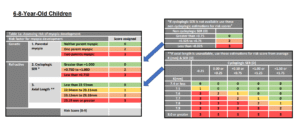
Figure 1: Part 1 of PreMo indicator.
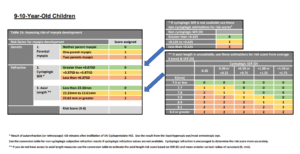
Figure 2: Part 1 of PreMo indicator.

Figure 3: Part 1 of PreMo Indicator.
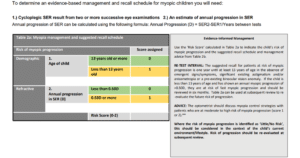
Figure 4: PreMo part 2.

Figure 5: PreMo part 2.
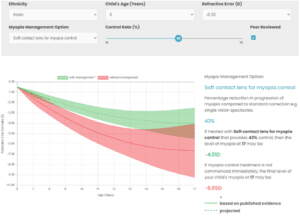
Figure 6: The BHVI myopia calculator.
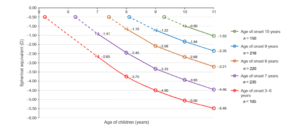
Figure 7: Yearly changes in spherical equivalent (D) of myopic children from age 7-11 years, stratified by age of myopia onset (n=928) D, dioptres.


